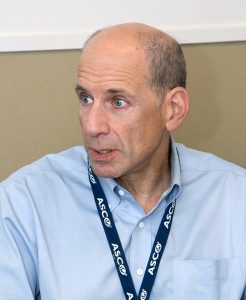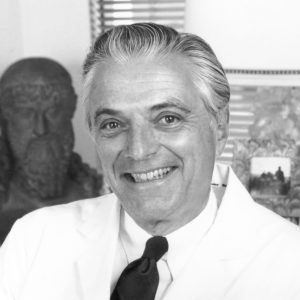 Research & Evaluation takes root with aspirations of growth
Research & Evaluation takes root with aspirations of growth
New leader tapped to lead and grow department
 Diana Petitti, MD, MPH, was appointed as director in 1993. Before joining R&E, Dr. Petitti worked with the Division of Research at Kaiser Permanente Northern California and as an epidemic intelligence service officer with the Centers for Disease Control and Prevention.
Diana Petitti, MD, MPH, was appointed as director in 1993. Before joining R&E, Dr. Petitti worked with the Division of Research at Kaiser Permanente Northern California and as an epidemic intelligence service officer with the Centers for Disease Control and Prevention.
The hire underscored SCPMG’s desire to expand the research program. Despite its long history, it remained significantly smaller than research programs in other regions.
“In the past, SCPMG has been less active in research than the Northwest and Northern California regions,” noted the announcement of Dr. Petitti’s appointment in Partners News. “Our goal is to develop the Southern California regional research department as a center of excellence for clinical and evaluative research in medical outcomes.”
Janis Yao, MS, a data reporting and analytics consultant who joined R&E around the time Dr. Petitti was hired, recalls that the department’s primary focus was to support the research projects of SCPMG physicians.
Yao, who had been working as a biostatistician, said she was seeking adventure when she applied to join the department. “I believed it would provide me a platform to grow,” she said.
The 1995 R&E Annual Report featured a study that Yao co-authored. Dr. David Sacks was the lead author. The paper, published in the American Journal of Obstetrics and Gynecology, examined glucose tolerance testing in pregnancy. The paper has since been cited 292 times and helped to pave the way for new criteria defining gestational diabetes. This influential study, along with others, helped to raise the profile of the research program.
The team began collaborating on projects funded by various industries and government organizations and expanded the scope and diversity of its research.
KPSC researchers became involved with several important research networks in the 1990s, including the Vaccine Safety Datalink and the Cancer Research Network.
Clinical trials began to be incorporated into practice
 Clinical trials also were ramping up during the 1990s, especially in San Diego. Jonathan A. Polikoff, MD, recalls transferring from Orange County after 5 years to San Diego in 1988 to be part of the action.
Clinical trials also were ramping up during the 1990s, especially in San Diego. Jonathan A. Polikoff, MD, recalls transferring from Orange County after 5 years to San Diego in 1988 to be part of the action.
While he was in Orange County, Dr. Polikoff incorporated some of the trials being performed at UC Irvine to Kaiser Permanente with the help of a UC Irvine fellow, but not many other physicians there were following the same path. However, at the same time, Scott Browning, MD, a physician in San Diego, was incorporating clinical trials from UC San Diego into Kaiser Permanente practice. Others in San Diego were also actively pursuing clinical trials, although finding funding and support was a challenge.
“Scott didn’t have a fellow like I did, but he got some funding for a clinical position through the UCSD research program,” said Dr. Polikoff. “Then, he wrote a grant in the early 1990s to become a CCOP, which is a community cancer oncology program. It was sponsored directly by the National Cancer Institute because they were trying to get community programs more involved in clinical research.”
“In 1993, the San Diego Medical Center began getting direct funding from the National Cancer Institute rather than through academic centers. That’s when things started to really take off. It was just San Diego at the time,” Dr. Polikoff added.
Among the early breast cancer clinical trials was a study that tested the breast cancer prevention drug tamoxifen versus a placebo, which the San Diego site participated in. “This was a truly groundbreaking study, but tamoxifen had some worrisome side effects,” Dr. Polikoff said.
At the same time, several multisite trials about cardiovascular disease also were going on, recalls Vicken J. Aharonian, MD, who began working at Kaiser Permanente in 1979. One study in 1995 examined the idea at the time that coronary disease was something that got worse and worse until someone died.
“We were trying to determine if treating the cholesterol would decrease coronary artery disease,” Dr. Aharonian said. “We found a lot of the patients did not progress and they basically lived with the disease. There are things that we can do to manage the situation and, in some cases, there was some regression too.”
The study “was an eye-opener” and changed the way physicians thought about coronary heart disease, he added.
The landmark ACEs study
 A collaboration between Vincent Felitti, MD, an SCPMG preventive medicine physician in San Diego, and Robert Anda, MD, of the CDC, resulted in a landmark study about Adverse Childhood Experiences.
A collaboration between Vincent Felitti, MD, an SCPMG preventive medicine physician in San Diego, and Robert Anda, MD, of the CDC, resulted in a landmark study about Adverse Childhood Experiences.
The first study, published in The American Journal of Preventive Medicine in 1998, examined the relationship between exposure to abuse, neglect, and household dysfunction during childhood and disease and behaviors in adulthood. They found a strong correlation between exposure to childhood adversity and multiple physical and mental health conditions later in life.
The study led to more studies over the next several decades, including several current studies at R&E.
“The original ACEs study was highly significant because it brought widespread attention to the impact that adverse childhood experiences have on lifelong health,” said Sonya Negriff, PhD, a research scientist in the Division of Behavioral Research. “The study has been replicated many times and now researchers including myself are working to understand the mechanisms of those associations and how we can work to prevent the negative outcomes.”
This new practical application of ACEs research continues the work Dr. Felitti pioneered, aimed at giving kids a better chance to grow up into mentally healthier adults.”





